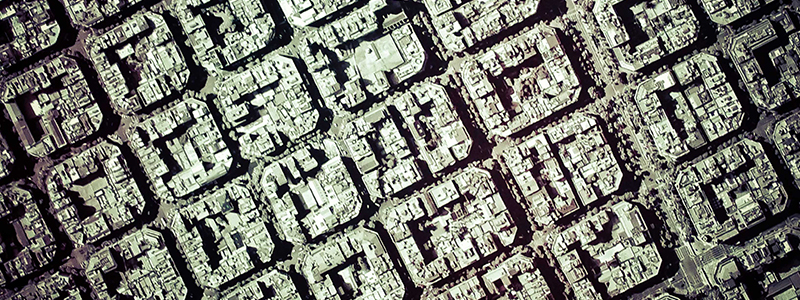“To every outworn shibboleth…he clung with fanatic tenacity.”
Robert Boothby
A shibboleth, in its original biblical use, refers to a variation in pronunciation used to differentiate between people; once identified as the other and thus the enemy, these mispronouncing folk were then summarily slaughtered. In our day the term is used for any hard-held idea that might set an individual or group apart, though consequences need not be fatal. Cultural criticism picks out shibboleths with the idea that behind their veneer of normalcy there lies some questionable ideology.
Taken this way, in Barcelona shibboleths abound, revered notions that help define what the city is all about.
In the quest to establish its place in the modern world, someone came up with the idea that putting Barcelona on the map should be taken literally. Along came the expansive Eixample, laid with all its geometrical audacity over a huge stretch of farmland. After imposing its rationalist grid and perpendicular lines, it was cartographically criss-crossed with wide avenues along longitude (Meridiana) and latitude (Paral·lel). Take a straight course out from either and, global traveller, you’ll end up where you started.
Since the 19th century the Eixample has been a statement of intentions: a city reaching beyond itself to the world and connecting with it. Subsequent World Fairs, the Olympics and even its current Smart City status have been premised on this ambitious though rather insecure idea.
Back within its blocks, architects and sociologists praise Cerdà’s Eixample plan for its rationalist, modern order. Since its principle is sameness, they say it represents democratic principles, like equality. The Eixample breaks down class distinction too, it predicates a middle class society. Cerdà even argued it would be hygienic, the solution to the squalor of the Raval, its long-time nemesis. Like democracy, it’s a great idea people have screwed up (like when all the inner courtyards were encroached upon); no one would dare suggest it’s fundamentally flawed and needs redoing.
[quote align=»left»]Of all the city’s districts, the Eixample is the one that least resembles a neighbourhoodBelieving all this, it’s easy to come to the conclusion that while the Eixample did not invent the wheel, it did get it rolling. And roll it does. Its most apparent democracy involves automobiles—they’re everywhere, and with them a democracy of noise and pollution. Parts of the Eixample have the worst air quality in the city, which is understandable given Gran Via and Diagonal are through freeways. But then, quite rightly, Eixample residents complain that making some streets pedestrian is not fair: everyone should have the right to walk right out of their front door into the roar of fumes.
Of all the city’s districts, the Eixample is the one that least resembles a neighbourhood. Shops and restaurants are of lower quality than its social status. Its weak community structure and dearth of parks is why few choose to raise a family there. Despite its pretended egalitarianism, socio-economic discrepancies are sharp, peaking at Passeig de Gràcia and tailing off at the ends. Even the elderly try to get out, and many do. When the PAH anti-foreclosure group chants “People without housing, housing without people”, they’re talking about the Eixample’s empty flats.
If all this constitutes an ideology, then its name might be Eixamplism. As suggested, its counterpoint is the Raval, though the usual binary arrangement has the Eixample solving the Raval’s problems, and never the contrary. Eixamplism exemplifies Barcelona, both physically and conceptually, at least for a certain bourgeois mindset. To test its allure, try telling any upstanding resident it sucks.








